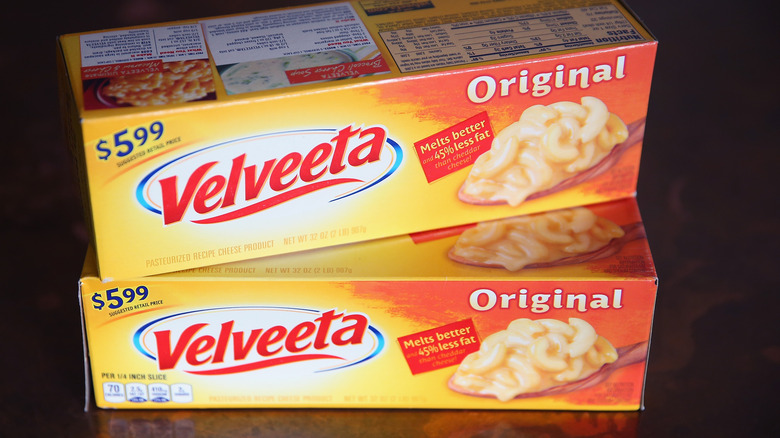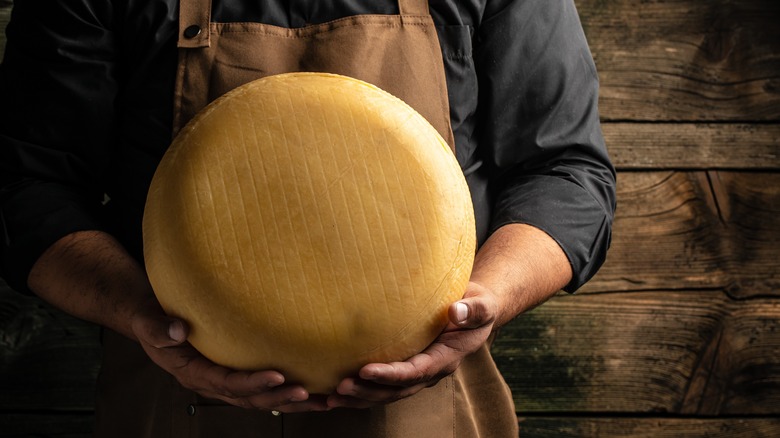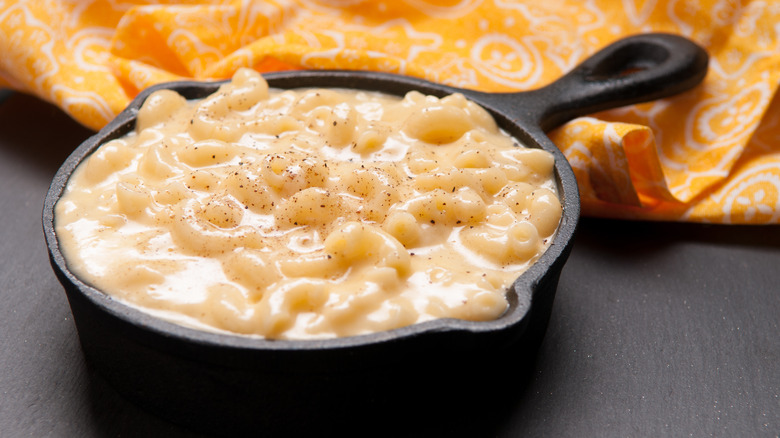Sorry, But Velveeta Isn't Technically Cheese
Seeing that signature box of salty, creamy liquid gold on the store shelf can get the mouth-watering in a hurry for a cheesy treat. Between a silky tortilla soup, gooey mac-and-cheese, or delicious queso dip, the potential for distinctive dishes you can create from that springy yellow block is seemingly endless. However, although Velveeta is often synonymous with cheese, some might be surprised to learn it's not technically the case.
According to the FDA, Velveeta is considered a "pasteurized processed cheese product." It states that to call a product cheese, it must meet specific criteria, like containing certain ingredients and falling within a certain range for moisture content. The process by which Velveeta is made, and what it contains, put it beyond that definition. While Velveeta has changed its formula since it began production to include whey and pasteurized milk, it still isn't technically cheese by the standard the FDA has set. In the early 2000s, the administration issued a warning letter to Kraft Foods informing them they were obligated to change the label on their packaging so it accurately described the product within. But just because this American staple isn't technically cheese, doesn't mean it's something to avoid.
The bold new method of making cheese
The product we know as Velveeta has actually been produced for decades. It was invented by Swiss immigrant Emil Frey to extend the shelf life of regular cheese in 1918, and just five years later, production volume reached the point that Velveeta incorporated. By 1927, Kraft had acquired Velveeta and began marketing it by showcasing its nutritional value. During World War II, Velveeta was widely popularized because of its affordability and capacity to enhance veggies and leftovers.
Velveeta was originally made by blending small bits of various cheeses, such as cheddar, Swiss, and Colby, together with an emulsifier, like sodium alginate. Today, the method for creating Velveeta involves using pasteurized milk, whey, emulsifiers, and salt. This procedure results in the golden, springy brick of spread we all know, and many love. The way Velveeta is made is part of the reason it doesn't meet the definition of cheese, but it's also precisely why it melts so well. Sodium citrate, the sodium salt of citric acid, is added during the process of creating Velveeta and allows the product to melt and reform easily. This is how the "cheese product" can be packaged in the perfectly shaped blocks we all associate with the name.
A signature indulgence
One of the most unique qualities of Velveeta is that it's shelf stable, and this is also because of the process and ingredients used to make it. It's why Velveeta is typically seen next to dry goods in a store rather than in a refrigerated section with other cheeses. But this doesn't mean it lasts forever; the shelf life for Velveeta, according to Kraft Heinz, is 210 days. While delicious, it's important to note that Velveeta is a product with an overall higher caloric and fat content than other cheeses. It also contains quite a bit of sodium at 410mg a serving, whereas a garden variety cheddar or brie will contain around 175mg.
So, the next time you're craving an irresistible nacho dip, don't be afraid to break out the Velveeta simply because of a technical definition. While it may be a bit more rich than traditional cheeses, the ease with which it melts saves valuable time in the kitchen when making a tempting, savory meal. And there isn't another product out there that tastes quite like it. But essentially all cheese, like chocolate, is considered a minor luxury, so go ahead and enjoy that delightful golden mac-and-cheese, and don't let definitions deter you from a good time.


